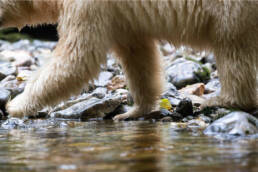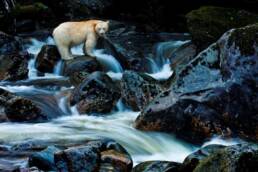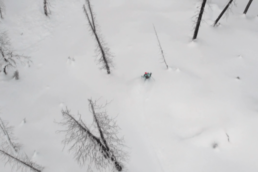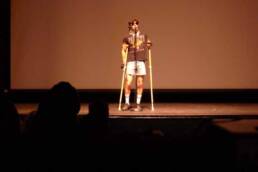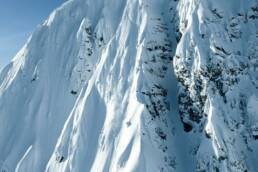Twenty years ago, this film could not have been made. But with new technology, an $8-million budget, and friends from Hollywood to Capitol Hill, one of the Pacific Northwest’s greatest modern-day conservationists is screening his natural-history tale at over 60 of the world’s biggest theatres. By Anthony Bonello.
Glowing tendrils of heavy West Coast mist shape-shift in the warming September morning, as filmmaker and conservationist Ian McAllister loads a Zodiac with camera packs and tripods. For the past 25 years, McAllister has used glorious days like this to showcase the formidable beauty of British Columbia’s Great Bear Rainforest and its charismatic fauna. McAllister fires off a few frames with his camera to acknowledge the beauty, but otherwise he is in a terse mood.
McAllister, executive director of the conservation non-profit Pacific Wild and director of the Great Bear Rainforest Imax film, is as warm as he is abrupt. That he is able to work from a satellite connection aboard his 14-metre catamaran and floating production base, named the Habitat, while anchored in the remote inlets of the Great Bear is as much a testament to his force of will as it is to technology. McAllister has taken on the biggest project of his life with this Imax film. With a budget of $8 million, it will be the largest natural-history film to come out of Canada.
McAllister takes me to visit the spot of one of the most intimate and cinematic scenes of his film. In it, a grizzly enters the frame and walks a well-worn trail; the camera follows along an elaborate cable system through the adjacent trees. The bear stops, rubs against a tree, and then exits stage right. It’s as if the entire scene was choreographed. What you don’t see is the camera crew scrambling to get the shot, caught off guard while they were preparing another scene with a team of Kitasoo scientists. It is the type of serendipity you cannot plan for in nature and an example of the film’s unique view into the Great Bear. “It’s a one in a million really,” McAllister says of the shot. When he first ventured into this river valley over 20 years ago, he spent weeks at a time sleeping in a hammock high in the trees hoping to get a glimpse of a grizzly bear.
Born in West Vancouver, McAllister was thrust into the conservation frontline in 1988 when he was 19 years old. His activist father, Peter McAllister, volunteered him to lead a blockade at Sulphur Pass in Clayoquot Sound on Vancouver Island. When they arrived, everyone had been arrested, so he was hoisted in a wicker basket above the blasting site for a logging road that would lead into a disputed wilderness area. “The contractor was shooting at me in the basket with a pellet gun, and all I had to read was the Margaret Atwood novel Bodily Harm.”
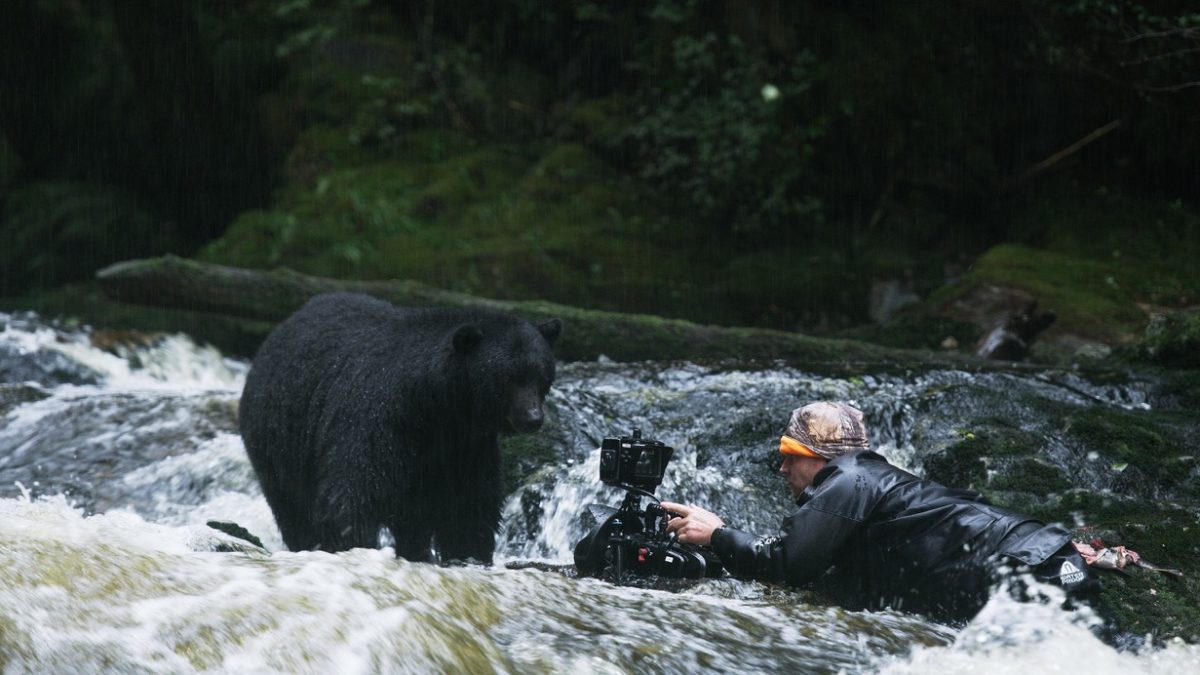
After Clayoquot Sound, McAllister began exploring the Mid Coast Timber Supply Area, the industrial name given to the chunk of wilderness we are currently in. He and his wife, Karen, spent seven years documenting and charting the more than 100 pristine river valleys that would become known as the Great Bear Rainforest. In 1996, they made a home in the heart of the Great Bear on Denny Island, where they started a family. They launched Pacific Wild in 2008 and have continued to work alongside First Nations and other conservation groups to raise awareness about the ongoing issues facing the coast—the recently approved liquefied natural gas (LNG) pipeline, tanker routes, open-net salmon fish farming, and trophy hunting, to name a few.
Since it’s harder to chain oneself to a grizzly bear than a tree, McAllister has focused his conservation efforts here on inspiring the public through imagery and storytelling. “You can only get arrested so many times. Maybe it’s a bit of a cop out, but when I would do speaking tours, once I put a photo up on the screen, people got it.”
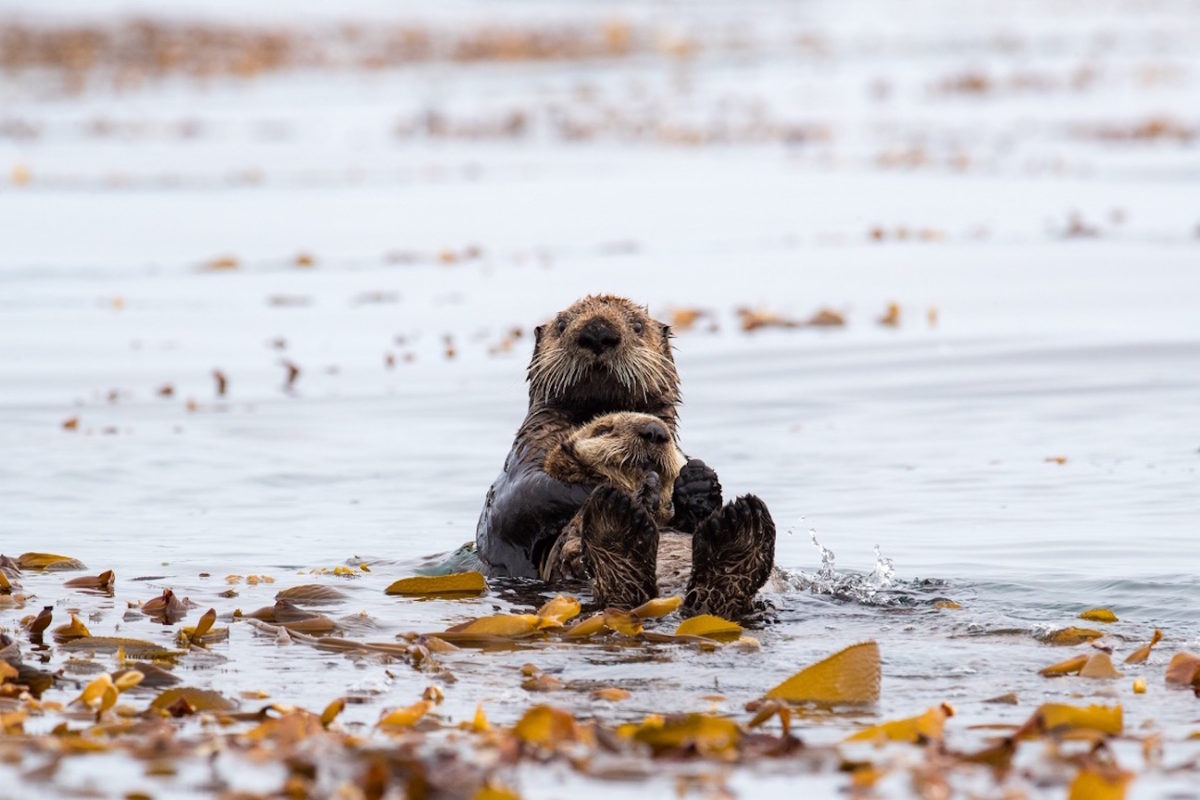
A prolific photographer, he has won awards and been published internationally, he has published six books and collaborated on a slew of children’s books. For someone who spends weeks at a time out in the field, often alone observing nature, McAllister can be charismatic and eloquent. He has built relationships with influential cultural figures ranging from politician Robert F. Kennedy Jr., who penned the foreword to one of his books, to singer Miley Cyrus, who did a social-media trip aboard the Habitat in 2015 to raise awareness of the wolf cull. Yet for all he has accomplished, he is not resting on his laurels with this massive Imax project.
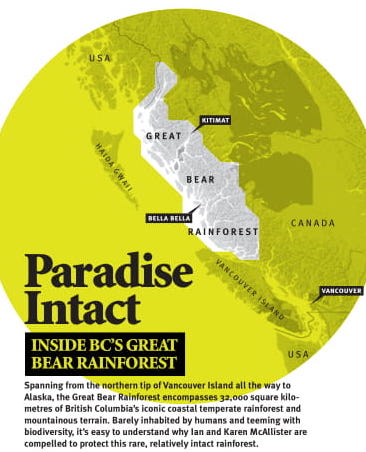
“Imax is a format that is as close to being here as you can get, and I thought it would be the best way to capture this place,” explains McAllister. One of the main incentives, however, is the fact that students and school groups make up 35 to 40 per cent of Imax audiences. “Education is a huge part of the Imax model, and we really want to educate young people on the Great Bear,” he adds. With more than a thousand Imax theatres in over 66 countries around the globe, it is clear why this project was important for McAllister to get off the ground. He may have spent over 400 days in the field during the last three years, but the film has been taking shape in McAllister’s mind for over 20 years. “I brought an Imax producer up to the Great Bear in the 90s, and it was immediately apparent that the hurdles were too large.”
At the time, Imax films used large cameras powered by noisy, heavy generators, not especially conducive to capturing truly wild animals in exceptionally remote locations. It wasn’t until the advent of digital cameras with larger sensors that it seemed possible to match the oversized 70mm celluloid film that Imax developed for its theatres, though no one had yet produced an Imax in digital. “The Imax fraternity said that it wouldn’t work, that a digital image wouldn’t be sharp enough or have the resolution for the big Imax screens,” recounts McAllister. After working closely with the innovative camera company RED Digital Cinema testing its then-unreleased 8K sensor, McAllister and his team won over the Imax community and continued to forge ahead.
Beyond the technical requirements, there were other hurdles to overcome. The Imax screen is designed to dominate the audience’s field of view, thus the camera movement needs to be especially slow so as to not make the audience feel sick. “Shooting Imax is not like shooting for television or regular film, so I had to totally relearn how to shoot,” explains McAllister. With Imax screens ranging from 16 to 30 metres high, shots need to be composed a lot wider. “The screen is so large that it can be overwhelming and sometimes even scare the audience. It’s really hard to resist wanting to zoom in tight on the detail of a bear tearing a salmon apart, but when projected four storeys high, it is just too much.”
 Camera operator Andy Maser spent over 130 days in the field with McAllister. “He was feeling the pressure. He had all the pieces in place: the funding, the people, the equipment. And then we would be waiting for nature to do its thing. That has to be stressful.” Maser recalls spending full days spent in the field and returning to the Habitat exhausted, where McAllister would pull up anchor. “We would do this crazy run all night on the boat to chase a scene.” As I learned first-hand, a night run does not entail being rocked gently to sleep in your bunk, but rather standing alert on deck keeping a lookout while McAllister is busy at his computer dealing with administrative duties and watching footage from the day, critiquing the smallest flaws in composition or animal behaviour. Sometimes it worked out and sometimes it didn’t,” Maser adds. “He was all in, and you have to support that.”
Camera operator Andy Maser spent over 130 days in the field with McAllister. “He was feeling the pressure. He had all the pieces in place: the funding, the people, the equipment. And then we would be waiting for nature to do its thing. That has to be stressful.” Maser recalls spending full days spent in the field and returning to the Habitat exhausted, where McAllister would pull up anchor. “We would do this crazy run all night on the boat to chase a scene.” As I learned first-hand, a night run does not entail being rocked gently to sleep in your bunk, but rather standing alert on deck keeping a lookout while McAllister is busy at his computer dealing with administrative duties and watching footage from the day, critiquing the smallest flaws in composition or animal behaviour. Sometimes it worked out and sometimes it didn’t,” Maser adds. “He was all in, and you have to support that.”
A lone wolf, demanding and unrelenting in style, McAllister has found himself the leader of an organization that has helped effect real change, like British Columbia’s grizzly bear hunting ban, which was instituted in 2018. As a director, he has brought together a creative team that includes names like Hans Zimmer, who scored the film, and Ryan Reynolds, the Canadian actor and Hollywood heartthrob who narrates it. Significantly, he has earned the trust of the Heiltsuk, Kitasoo, and Gitga’at to represent the land and their people. Doug Neasloss, an elected chief and resource stewardship director for the Kitasoo, says, “You can tell McAllister is deeply connected to this area. He lives in the heart of the GBR [Great Bear Rainforest]. He has raised his family here. He has been in the trenches working with us.”
“I really wanted the culture of the people that have lived in the Great Bear for thousands of years to be an important part of the film,” explains McAllister, “and that comes through in the young First Nations characters that we have in the film.” Neasloss seconds this sentiment, “To have youth involved is important. They are the people that will inherit this area, and the more they are involved, the stronger they will be in the future.”
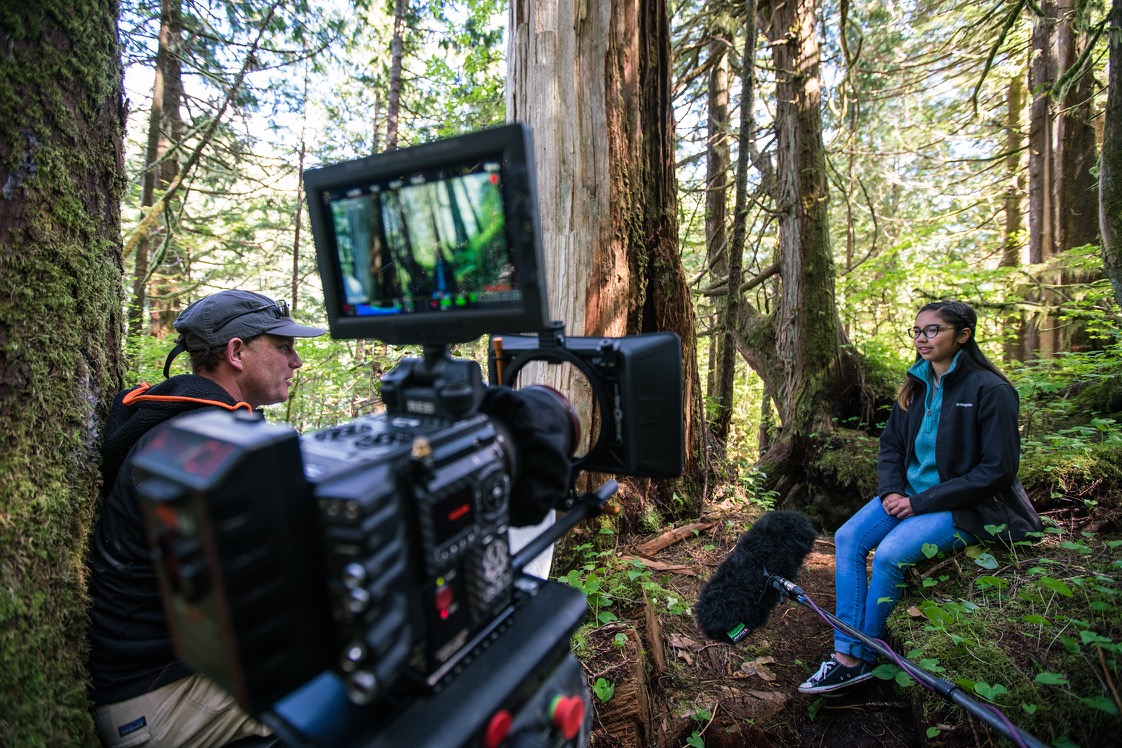
Aboard the Habitat, Deirdre Leowinata, McAllister’s camera assistant, loads some behind-the-scenes Imax footage. In one clip, McAllister is lying in a rushing stream, placing a camera barely half a metre from a black bear fishing for salmon. The bear is comfortable with his proximity and pays him no heed, continuing to fish. It is an abrupt reminder of the power behind the animal’s docile persona. It is fearless stuff, yet as McAllister offers me a preview of the Imax film, he asks, “Just let me know if you think it is any good?” The prospect of completing the film after so much hard work is clearly as intimidating as it is relieving.

Like any artist, and especially one with a cause, McAllister has found the film all-consuming. “He misses his kids terribly, and maybe even me too!” laments Karen, who now lives on Vancouver Island, where the children go to school. “We see him on breaks between shoots and editing stints, which are in Vancouver, and the kids and I go up to Bella Bella for the summers and school breaks.”
I press McAllister on how he has remained committed to protecting the Great Bear in the face of issues like diminishing salmon returns and the imminent LNG terminal in Kitimat that will see tanker traffic travelling the waters of Douglas Channel. “I’ve never, ever felt like not doing it, but you do get overcome by the sense of futility,” he says. “It’s definitely a roller coaster of emotions. Unfortunately the threats get more complex and they get more severe. So much connects to climate change and the timeline to change is that much shorter. But the way that we inspire people hasn’t changed.” He goes on to describe a sequence of whales breaching. The footage didn’t make the final cut, but it shows how progress has been made. “One of the great successes on the coast has been the return of the whales. Twenty years ago, seeing a whale was rare. Before 20 years ago it was unheard of. Today whales are back in numbers that we couldn’t have conceived of then. I thought the return of the whales would be a bigger story, but there was no room for it.”
There are multiple scenes that McAllister and his team put days and weeks into that won’t make the film. At 42 minutes long, the film couldn’t fit all the footage. Yet, before this film has even gone to print, McAllister is already gathering footage for a potential follow-up. “After the initial learning curve, it’s hard to go back to something else,” he says
Back aboard the Habitat, Leowinata plays back footage captured during the expedition. McAllister stops at a scene he shot of a mother grizzly nursing her three cubs. “Play it again,” he insists. “That’s so cool.”
He has an almost childlike wonder. Whatever pressures exist from investors and donors, or the constant threats facing the place that he has dedicated his life to, his sense of serendipity and wonder is not yet lost. And when the Imax hits the big screen, it will not be lost on audiences.
Filmmaker and writer Anthony Bonello has saved much of the world onto hard drives over his career, with ski films like Snowman and Azadi:Freedom. His 2013 film, Stand, took him to the Great Bear Rainforest. He keeps coming back.
Related Stories
Spoil – Documentary on the Great Bear Rainforests
Is the economical growth in Canada worth destroying the entire West Coast of Canada? SPOIL - A powerful documentary on…
Great Canadian Birds Eye Beautifulness
There is so much great media coming out of the Kootenays these days. Here's a great clip shot and edited by B4apres…
Goat Style Bike Jam Goes This Weekend
Based in sunny Creston, BC, the Kootenays very own slopestyle competition goes this weekend, attracting some of the…
Dave Treadway Goes Big in the Selkirks
Some like to say that the mountains in and around Nelson, BC aren't that big. The Coast, Revelstoke, the Rockies,…
Patagonia Goes Fair Trade
This is big news. Patagonia Inc., the outdoor apparel company and CMC partner, is proud to announce its plans to offer…


